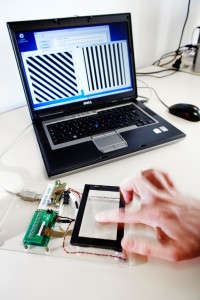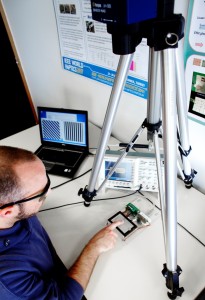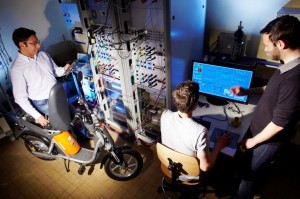Scientific Developments
Compliance with new energetic constraints and aspirations to new functionnalities induce the development of complex electromechanical systems. To be operational, these systems require a suitable management performance which passes through the command.
The L2EP’s Control team develops original methods for modeling and control in the context of systemic. Since the development of the Causal Ordering Graph (GIC) in collaboration with the Laplace laboratory, the team is always focused on a methodological approach of the control for systems that are becoming more complex and tightly coupled.
The Energetic Macroscopic Representation (EMR) s a formalism based on the causal representation of physical systems. The control structure of a principal process is achieved by reversing step of the model described by the full respect for natural causality. This method is applied to systems involving energy couplings and / or functional.
The Generalized Vectorial Formalism (GVF) is a generalization of the approach « Space Vector », developed to treat more than two independent current systems: Typically, associations converters n legs – multiphase electrical machines. The result leads to a split of the system into sub-coupled systems which can be advantageously represented by the EMR and the control structure is then easily deduced. The generality of this mathematical approach also allowed its application to multi-actuated mechanical systems coupled.
The approach is « top-down » in that formalisms developed bring powerful controls on the devices. It is « bottom-up » in the sense that the studied applications enrich formalisms.
Field of Applications
The team is interested with the control of systems with energy couplings and / or functional couplings:
– Hybrid Electric Vehicles and Multiphase fault-tolerant drives.
– Piezo-electric Systems.
Examples
Electrovibration signal design
Electrovibration technique can modify user’s perception of a surface through the modulation of the sliding friction accordingly to the voltage applied. This web tool comprises a novel approach to virtual haptic rendering in electrovibration based haptic displays in order to provide realistic feeling of a simulated surface. The required voltage signal is obtained using a simplified equation, confirmed by the use of a finite element computational framework, able to simulate tactile scenarios on real surfaces, e.g. finger pad sliding on a grated surface, and also on virtual surfaces, i.e. the friction modulation due to the electrostatic attraction between the finger pad and the flat haptic display. A database was generated, based on the precomputed tactile scenarios on simple reference standards, for the use with a conditional average estimator method, to predict outputs for custom parametric surfaces. In addition, an experimental database obtained by active exploration of different surfaces, is utilised for texture rendering.
HapTex is a web tool for virtual rendering of textures for electrovibration based haptic displays, based on FEM simulations of tactile scenarios, and an experimental database, using a conditional average based artificial neural network. The online simulation tool can be found at HapTex
Design and control of systems with tactile feedback piezoelectric actuation
The team develops tactile feedback systems (basic prototype « STIMTAC ») ased on the variation of the friction coefficient between a vibrating plate, piezo-electrically actuated, and the finger of a user. This principle is patented by the University Lille 1, resulting in a collaboration with ST Microelectronics and a European project ITN Marie Curie (Prototouch). This part of the IRCICA and MINT team of INRIA LNE.
Energy management in hybrid electric vehicles
LThe team coordinates the national project MEGEVH (Modeling Energy and Power Management of Hybrid Vehicles) the RT3 network of the Ministry of Research. She works on the modeling system and energy management of hybrid vehicles (with the FEMTO-ST, LTE-INRETS and Nexter System). The developed formalism and EMR offer a unified view of different vehicle hybridization structures.
Platform Electricity and e-V Vehicles
This platform aims to enable real-time energy management for new vehicle concepts for transportation systems to be more efficient and less polluting. This is achieved through the concept of Power Hardware In the Loop (HIL) to simulate the environments of power traction systems.
This platform includes 10 electric machines, static converters, control cards, a super-capacitor bank, a fuel cell, batteries and light electric vehicles.











